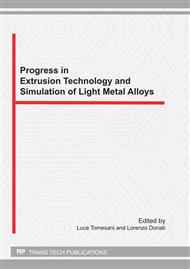p.1
p.11
p.19
p.27
p.35
p.43
p.51
p.59
Extrusion Benchmark 2011: Evaluation of Different Design Strategies on Process Conditions, Die Deflection and Seam Weld Quality in Hollow Profiles
Abstract:
In the paper experimental investigations aimed at allowing a detailed and accurate comparison of different FEM codes were presented and discussed. Two hollow profiles within the same die were characterized by different thicknesses within the profile, two welding chambers and critical tongues (one fully supported and one partially supported). The material flow balance was performed by means of feeder size and position on a profile and by means of bearings on the other one. Accurate monitoring of process parameters was carried out by using a self-calibrating pyrometer for profile temperature, six thermocouples for die thermal monitoring, a laser velocitymeter for profile speed and two laser sensors for die deflection on critical tongues. AA6082 alloy was used as deforming material, while H-11 hot-work tool steel was selected for the die material. The experiments were repeated at least three times under the same conditions in order to provide a nearly steady state statistical distribution of the acquired data. These are used as a reference for the 2011 edition of the extrusion benchmark.
Info:
Periodical:
Pages:
1-10
Citation:
Online since:
September 2011
Keywords:
Price:
Сopyright:
© 2012 Trans Tech Publications Ltd. All Rights Reserved
Share:
Citation:


